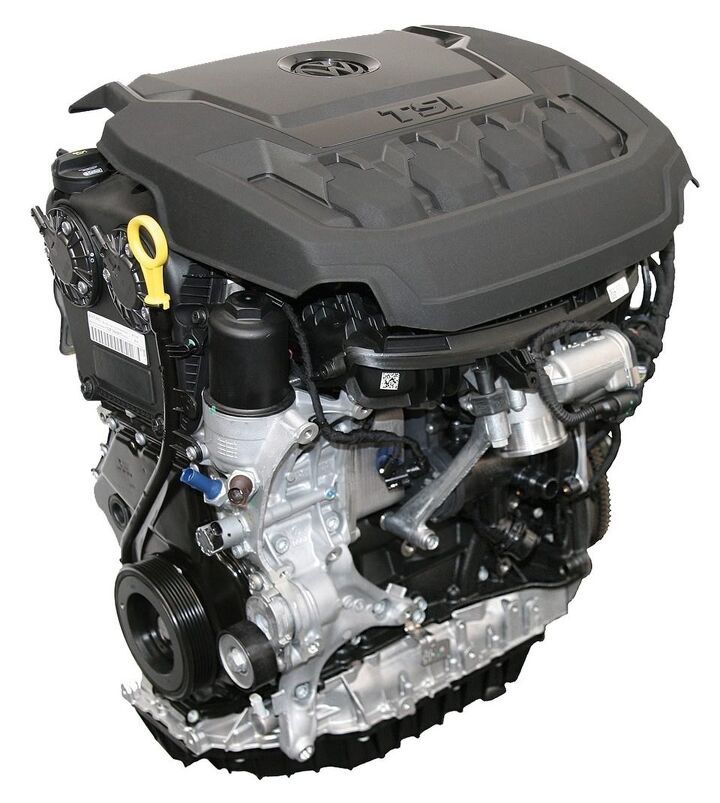Another New Volkswagen 2.0T Debuts in 2018 Tiguan, Prepares to Replace 1.8T in Passat and Beetle
Complete with an alternate Miller Cycle that Volkswagen is calling the “Budack Cycle,” the German automaker has evolved its ubiquitous EA888 2.0-liter turbocharged four-cylinder engine for installation in the second-generation 2018 Volkswagen Tiguan.
Horsepower? For a 2.0T, it’s rather unimpressive at only 184 ponies. But Volkswagen isn’t caught up in horsepower per liter figures. Instead, Volkswagen’s own introduction of this “Budack Cycle” 2.0T makes the company’s existing 1.8T — currently on duty in four product lines — sound downright ineffective.
Naturally then, Volkswagen won’t reserve the Budack Cycle EA888 2.0T solely for the 2018 Tiguan. According to Volkswagen of America communications manager Mark Gillies, “It will eventually supersede the 1.8T in the Passat and Beetle.”
From this we learn two things.
First, the EA888 Gen3B 184-horsepower 2.0T isn’t bound for the Golf and Jetta, the latter of which is due for replacement next year. Second, the existing Beetle that is oft rumored to be dead will clearly live — at least long enough — to see the installation of a new engine.
As for the EA888 Gen3B powerplant that will first appear in the Tiguan, it’s no powerhouse compared to the 2.0T in, say, the Volkswagen Golf R. There, Volkswagen’s 2.0T produces 292 horsepower.
But again, it’s not the displacement that matters as much to Volkswagen as the comparison with the 1.8T and the old Tiguan’s premium fuel-swilling 2.0T. Prior to official numbers being made available by the EPA, Volkswagen says the new 2.0T will consume less fuel than the 1.8T while producing 21 percent more torque: 221 lb-ft, 14 more than the old Tiguan’s old 2.0T.
Volkswagen says the additional torque is produced because this new 2.0T “closes the intake valves much earlier.” Along with prolonging combustion, this means “faster air flow for the incoming gases, which improves the mixing of the fuel and air.”
While the 2.0T produces only 14 more horsepower than the existing 1.8T, the peak pony output arrives at 4,400 rpm rather than 4,800. All 221 lb-ft of torque are accessible at a low 1,600 rpm.
At least for 2018, the new Tiguan’s powerplant offerings will be limited to the 184-horsepower 2.0T. Keep in mind, the two best-selling utility vehicles in its segment — Rogue and CR-V — don’t offer hi-po engine upgrades, either.
Timothy Cain is the founder of GoodCarBadCar.net and a contributing analyst at The Truth About Cars and Autofocus.ca. Follow on Twitter @timcaincars.
More by Timothy Cain
Latest Car Reviews
Read moreLatest Product Reviews
Read moreRecent Comments
- Oberkanone GASIS = Department of Energy Gas Information System
- Kjhkjlhkjhkljh kljhjkhjklhkjh Every president *regardless* of political affiliation should be prosecuted for doing this. No president can affect gas prices, cant even make a baker make a rainbow cake. All OPEC will do is lower output to keep the price higher. Thanks grandparents lobbyists from 60 years ago for F##king the US until 90% of call cars run on electrons..
- Cprescott The problem with this is that there is no supply crisis. So one has to wonder what crisis is being fabricated to justify further depletion of reserves that are already at 1980's levels. You be the judge. But it is not to make lives of Americans less expensive.
- Dave M. To paraphrase Bill Kilgore, I love the smell of triggered MAGA in the morning.....
- Jonathan Sounded interesting, until I got to the all electric part. No thanks.



































Comments
Join the conversation
So, all you need to do to wake this engine up is a cam with more intake duration and a tune?
Seems like this engine would pretty much moot the point of the TDIs even if they weren't gone for other reasons. 221 lb-ft from 1600 RPM, great efficiency, etc.